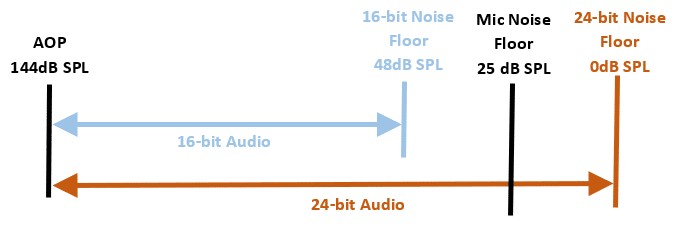Legacy communication systems for noise adverse environments are designed with 12-bit to 16-bit audio codecs. 16-bit audio provides 96dB of dynamic range. Noise reduction requires estimation the noise power spectrum, and the SNR. 16-bit audio is a natural choice for low power embedded DSPs because they can efficiently implement 16 by 16 multiple and accumulates required for the power calculations of a noise reduction algorithm.
In applications where the level of the background noise has a large range of potential SPLs, 16-bit of dynamic range may not be enough to capture the acoustic scene of the environment. 24-bit audio provides 144dB of dynamic range, allowing for the sound capture of a pin drop to a jet engine without saturating or under representing the signal. The quality of digital MEMS microphones has improved to point where the noise floor and acoustic overload point (AOP) have a dynamic range greater than 96dB. The effective cost point of MEMS microphones make them a viable option to be implemented in modern communication systems.

The question is can we used these extra bits effectively? For VOCAL’s NR, the answer is yes. The 24-bit audio can be transformed into a representation that allows for effective estimation of signals using fixed point arithmetic. This noise reduction implementation provides the ability to perform high quality audio on low power fixed point DSPs.
VOCAL Technologies offers variety of off-the-shelf and custom designed solutions for noise reduction. VOCAL offers a variant to its noise reduction software that supports a 32-bit interface with the 24-bit audio stored in the most significant bits.